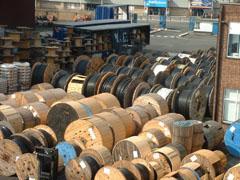Cable (Insulated)
| Infobox on Cable (Insulated) | |
|---|---|
| Example of Cable (Insulated) |  |
| Facts | |
| Origin | - |
| Stowage factor (in m3/t) | - |
| Humidity / moisture | - |
| Ventilation | - |
| Risk factors | Moisture damage, mechanical damage, theft (copper) |
Cable (Insulated)
Contents
Description
A cable is most often two or more wires running side by side and bonded, twisted or braided together to form a single assembly, but can also refer to a heavy strong rope. In mechanics cables, otherwise known as wire ropes, are used for lifting, hauling and towing or conveying force through tension. In electrical engineering cables are used to carry electric currents. An optical cable contains one or more optical fibers in a protective jacket that supports the fibers.
Modern power cables come in a variety of sizes, materials, and types, each particularly adapted to its uses. Large single insulated conductors are also sometimes called power cables in the industry.
Cables consist of three major components: conductors, insulation, protective jacket. The makeup of individual cables varies according to application. The construction and material are determined by three main factors:
- Working voltage, determining the thickness of the insulation;
- Current-carrying capacity, determining the cross-sectional size of the conductor(s);
- Environmental conditions such as temperature, water, chemical or sunlight exposure, and mechanical impact, determining the form and composition of the outer cable jacket.
Cables for direct burial or for exposed installations may also include metal armor in the form of wires spiralled around the cable, or a corrugated tape wrapped around it. The armor may be made of steel or aluminum, and although connected to earth ground is not intended to carry current during normal operation.
Power cables use stranded copper or aluminum conductors, although small power cables may use solid conductors.
The cable may include uninsulated conductors used for the circuit neutral or for ground (earth) connection.
The overall assembly may be round or flat. Non-conducting filler strands may be added to the assembly to maintain its shape. Special purpose power cables for overhead or vertical use may have additional elements such as steel or Kevlar structural supports.
Some power cables for outdoor overhead use may have no overall sheath. Other cables may have a plastic or metal sheath enclosing all the conductors. The materials for the sheath will be selected for resistance to water, oil, sunlight, underground conditions, chemical vapors, impact, or high temperatures. In nuclear industry applications the cable may have special requirements for ionizing radiation resistance. Cable materials may be specified not to produce large amounts of smoke if burned. Cables intended for underground use or direct burial in earth will have heavy plastic or metal, most often lead sheaths, or may require special direct-buried construction. When cables must run where exposed to mechanical impact damage, they may protected with flexible steel tape or wire armor, which may also be covered by a water resistant jacket.
Cables for power distribution of 10kV or higher may be insulated with oil and paper, and are run in a rigid steel pipe, semi-rigid aluminum or lead sheath. For higher voltages the oil may be kept under pressure to prevent formation of voids that would allow partial discharges within the cable insulation.
Modern high-voltage cables use polymers or polyethylene, including XLPE for insulation. They require special techniques for jointing and terminating.











